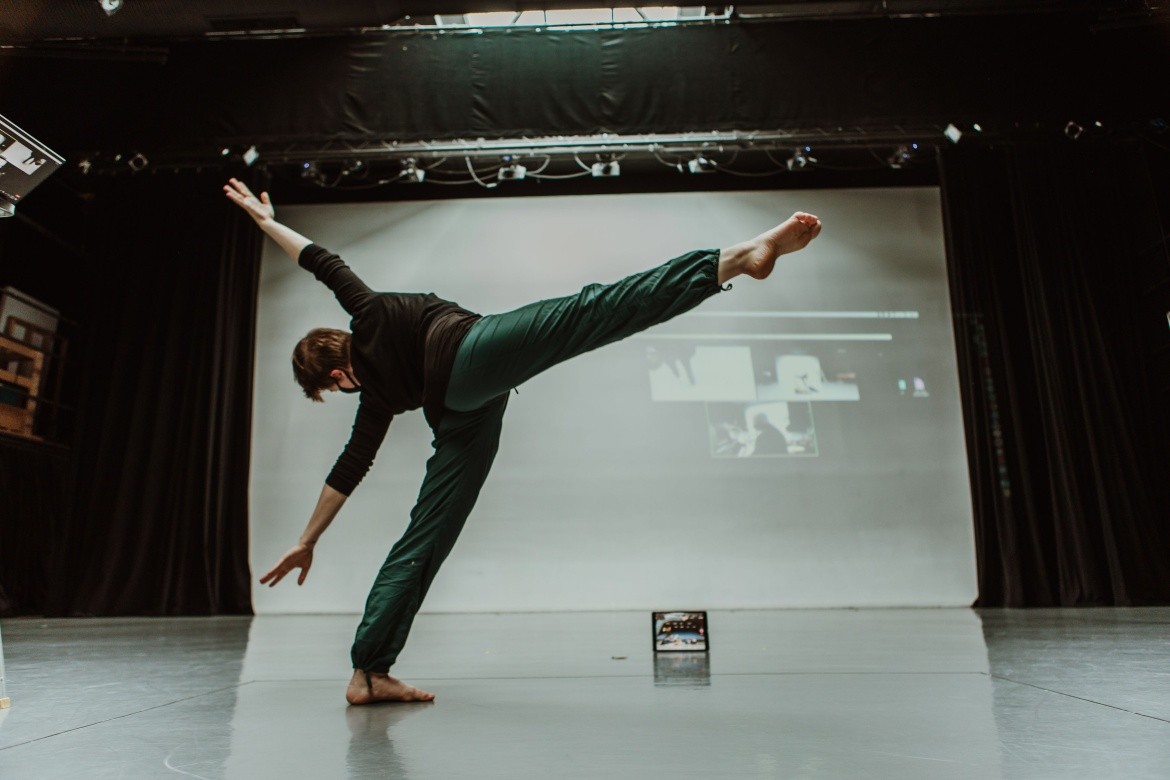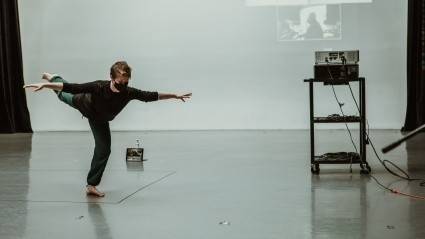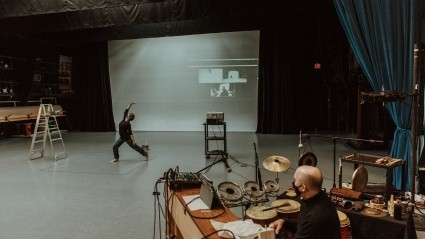All the angles

Dance instructor Barbie Diewald used an iPad, laptops, a ladder and many props to bring the dance studio to her Mount Holyoke students — remotely.
By Keely Sexton
When COVID-19 forced Mount Holyoke to deliver classes online, Barbie Diewald, assistant professor of dance, was committed to finding a way to deliver the same learning to her students that her in-person classes had always been: a space to explore, to learn and to grow individually and with the class.
Faced with the challenges of teaching a subject that is grounded in physicality and intimacy, Diewald put a lot of thought and consideration into how to capture the magic of her classes and convey it over Zoom. She and Peter T. Jones, a senior lecturer in the dance department who serves as her accompanist, spent the summer designing a course that they hoped would do the trick.
Diewald and Jones set up a space in the dance studio where they could work safely together — spaced 15 feet apart and masked — to bring as full a classroom experience to her students as they could. Diewald taped off a 7-by-5 rectangle on the floor to mimic the space constraints that her students might face working in a small area of their bedrooms, basements, garages or living rooms. She choreographed movements to fit within that space, and, using an array of computers and different angles, videoed herself dancing, in real time, so students could study her movements.
“The students used to be able to know what my body was doing on the ground because they were able to stand over and see,” said Diewald. “We really can’t capture that with one camera, so we shot multiple angles and students could decide to pin the angle that they needed on Zoom.”

Another of the key components of her class that Diewald wanted to bring intentionally into the remote space was the intimacy that she cultivated with her students. The closed space of the studio where they could feel free to learn and move together created a strong sense of trust and community in the classes. Rather than hope that it would develop naturally over the course of the module, she made a conscious decision to make fostering community one of the learning goals of the course.
“I separated the students into small groups, which met both with me and without me every single week. So we were able to be in conversation. We had agenda-less conversations where we would just talk to each other,” she said.
In addition, Diewald found that virtual office hours — which in person were sparsely attended and usually only by those facing challenges — lent themselves to a more casual, drop-in kind of meeting that the students readily engaged with.
“People will just sort of pop in and just want to touch base about something. And so I feel like I have gotten to know my students quite a bit better,” she said.
And, because her courses were now confined to seven-week modules, the daily classes meant that little time was lost to refocusing; their work had a continuous flow that was supported by daily meetings.

But the two-module system did come with challenges: Diewald decided that instead of developing and performing final projects within such a short space of time, she would have her students conceptualize a dance project to be performed at a later time, carrying them forth into the future.
Another perk? Diewald was able to bring dance practitioners and experts from around the country to meet with her students, which would not have been possible in the days before remote learning.
“It has been very gratifying to see the students be in conversation with these figures that I admire,” she said. “Every guest that I’ve had has written to me immediately after and just said it was such a pleasure to be with these students.”
Diewald has found that working remotely has developed her practice and her teaching in unexpected ways. She has a deeper and stronger connection with Jones, which is something she is delighted to share with her current students, as well as the ones in the future — who will no doubt be the beneficiaries of their stronger connection.
“We’ve been working together for a long time, but I feel like something has shifted,” she said. “I can’t wait to get back in the studio and work with him and the students again.”